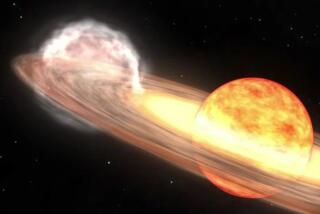Satellites Spark a Worldwide Heads-Up
- Share via
VALLEY FORGE, Pa. — The glint in the sky looks at first like a big star but ignites spectacularly, rivaling the moon’s brightness. Then, in a few seconds, it fades.
“I just say ‘Wow’ when I see a really good one,” said Terry Pundiak, an Allentown physician and amateur astronomer. “I’m surprised they don’t cause more reports of UFO sightings.”
This newfound heavenly body is no unidentified flying object but one of a year-old constellation of low-orbiting satellites called Iridiums, and spotting their 5- to 30-second flashes is the latest celestial fad.
Planetariums lead nighttime Iridium vigils. Internet message boards burn with anecdotes and technical details. Backyard stargazers spend evenings counting how many they can spot with the naked eye.
“On any given night you have a good chance of seeing them, and you don’t need a telescope,” said Ron Dantowitz, astronomer at the Museum of Science in Boston. “You just need at least one good eyeball.”
Motorola first launched the rotating Iridium satellites in May 1997, and the first flares were reported the following August.
Each Iridium has three mirror-like antennas about the size of a door. Unlike the surfaces of other satellites, which are concave or not very reflective, Iridium antennas are flat, silver-coated Teflon panels. When sunlight hits at a certain angle, an Iridium casts a brilliant reflection up to 30 times brighter than Venus, reaching a patch on Earth of about 20 square miles.
“I saw one that practically burned my retinas out,” said Randy John, a computer programmer and amateur astronomer in Pleasant Hill, Calif.
With about 70 Iridium satellites in orbit--including about half a dozen broken, or tumbling, satellites that emit less predictable flashes--observers just about anywhere in the world can see a dozen flares of varying brightness in a single evening. The brightest can be seen through clouds, in daylight or from the inner city.
The satellites’ orbits are so punctual that the flares can be predicted to the second.
Queens University chemistry professor Brian Hunter of Ontario was probably the first to report an Iridium flare, followed shortly by Don Gardner of Columbia, Md. Most of the discoveries are chronicled on a dozen or so Web sites now dedicated to Iridium flares.
The flares quickly became eye candy for professional astronomers as well. In October 1997, a rooftop flare-spotting session was held at the 48th International Astronomical Congress in Turin, Italy.
“As fascinating as the natural night sky may be, on any given night it does not vary much, except for the short-lived streaks of falling stars or meteors,” said solar physicist Bart De Pontieu of Palo Alto, Calif. “To me, artificial satellites add a touch of motion and surprise to the otherwise steady, unchanging night sky.”
Astronomers feared at first that satellite flares would be disruptive because they can be mistaken for a comet or meteor and leave a sky-long white streak in photographs.
“It could be misconstrued as landing lights from an airplane or even a nova,” said amateur astronomer Jeff Hunt of Charlotte Hall, Md., who maintains one of the foremost flare-predicting Web sites.
But most sky watchers have found the flares are predictable enough that they aren’t a problem. Moreover, the brilliant flares have been a boon to stargazing.
“The Iridium satellites could become astronomers’ unwitting partners in building an interest in the night sky for the Star Wars generation, which has been hard to impress with telescopic views of deep sky objects,” said amateur astronomer Russell Sipe of Anaheim Hills.
Sipe said he witnessed the “wow factor” of Iridiums at a softball game in Southern California recently, when he knew that a satellite would flare overhead. “We stopped the game for a few minutes. All of a sudden there are 25 or so people looking up, watching in awe. And for those few seconds, that had them thinking about space and astronomy,” Sipe said.
More to Read
Sign up for Essential California
The most important California stories and recommendations in your inbox every morning.
You may occasionally receive promotional content from the Los Angeles Times.













